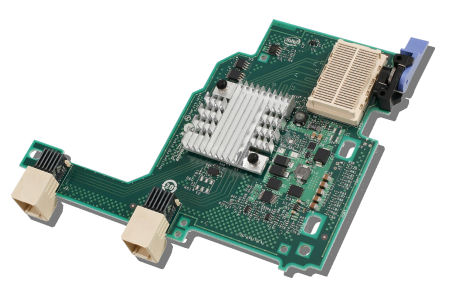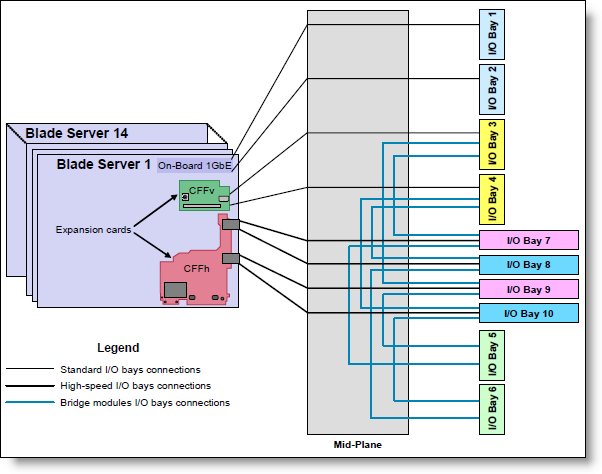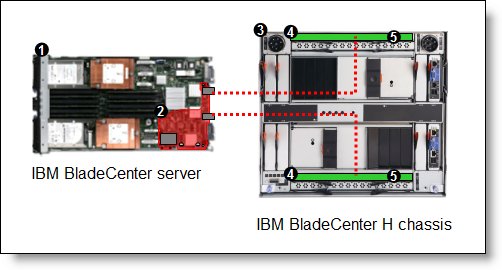Abstract
The Intel 2-port 10 Gb Ethernet Expansion Card (CFFh) for BladeCenter is a dual-port 10 Gb Ethernet card that is powered by an Intel Ethernet 82599 third generation 10 Gb Ethernet Controller. This card offers full line-rate 10 Gbps performance for high-IO intensive clients, and showcases the next generation in 10 GbE networking features for the enterprise network and data center.
Note: This adapter is withdrawn from marketing.
Introduction
The Intel 2-port 10 Gb Ethernet Expansion Card (CFFh) for BladeCenter is a dual-port 10 Gb Ethernet card that is powered by an Intel Ethernet 82599 third generation 10 Gb Ethernet Controller. This card offers full line-rate 10 Gbps performance for high-IO intensive clients, and showcases the next generation in 10 GbE networking features for the enterprise network and data center.
Data Center and Large Enterprise customers demand reliable performance from their networking equipment to ensure quick and easy deployment and provisioning of new systems, provide uninterrupted application services across their network to their users, and require maximum network performance for those applications. In addition, this adapter supports the latest virtualization technology, Intel Virtualization Technology for Connectivity (Intel VT for Connectivity).
Figure 1 shows the Intel 2-port 10 Gb Ethernet Expansion Card (CFFh).

Figure 1. The Intel 2-port 10 Gb Ethernet Expansion Card (CFFh)
Did you know?
Intel VT for Connectivity is a suite of hardware assists that improves overall system performance by lowering the I/O impact in a virtualized environment. This improves CPU usage, reduces system latency, and improves I/O throughput. Intel VT for Connectivity includes two major components: Virtual Machine Device Queues (VMDq) and Intel I/O Acceleration Technology (Intel I/OAT).
Part number information
Table 1. Ordering part number and feature code
| Description | Part number | Feature code |
| Intel 2-port 10 Gb Ethernet Expansion Card (CFFh) for BladeCenter | 42C1810* | 3593 |
* Withdrawn from marketing
These part numbers include the following items:
- One Intel 2-port 10 Gb Ethernet Expansion Card (CFFh)
- Documentation package
Features
The expansion card has the following features:
- CFFh form-factor
- PCI Express x8 Gen 2 host interface
- Intel 82599 ASIC
- Two full-duplex 10 Gb Ethernet ports that operate in standard physical NIC (pNIC) mode
- Connectivity to high-speed I/O module bays in BladeCenter H and BladeCenter HT chassis
- Wake on LAN support
- Serial over LAN/cKVM support
- PXE boot support
- VLAN tagging support
- Jumbo frames support
- Failover support
- BladeCenter Open Fabric Manager support
- iSCSI support with native operating system initiators
Performance features:
- I/O advanced technology (I/OAT) acceleration
- Virtual Machine Device Queues (VMDq)
- TCP/IP checksum offload
- TCP/IP segmentation offload
Intel I/O Acceleration Technology (Intel I/OAT) is a suite of features that improves data acceleration across the platform, from networking devices to the chipset and processors, which helps to improve system performance and application response times. The different features include Intel® QuickData, Direct Cache Access (DCA), MSI-X, Low-Latency Interrupts, Receive Side Scaling (RSS), and others.
Virtual Machine Device Queues (VMDq) reduces I/O impact on the hypervisor in a virtualized server by performing data sorting and coalescing in the network silicon. VMDq technology makes use of multiple queues in the network controller. With VMDq, as data packets enter the network adapter, they are sorted, and packets to the same destination (or virtual machine) are grouped together in a single queue. The packets are then sent to the hypervisor, which directs them to their respective virtual machines. Relieving the hypervisor of packet filtering and sorting improves overall CPU usage and throughput levels.
The expansion card has iSCSI support for proven native OS and VMM iSCSI initiators. Historically, CRC32C computation has degraded system performance, but now with the CRC instruction set included in the latest Intel Xeon processors, CRC validation is possible with minimal impact to network throughput while delivering data integrity.
Operating environment
This card is supported in the following environment:
- Temperature: 0° C to 55° C (32° F to 131° F)
- Operating power: Approximately 10 watts
- Dimensions: Approximately 15.9 cm x 12.5 cm (6.26 in. x 4.92 in.)
Supported servers
The Intel 2-port 10 Gb Ethernet Expansion Card (CFFh) is supported in the BladeCenter servers listed in Table 2.
Table 2. Supported servers
| Intel 2-port 10 Gb Ethernet Expansion Card (CFFh) | 42C1810 | N | Y | Y | Y | Y | Y | N | N | N | N |
Figure 2 shows where the CFFh card is installed in a BladeCenter server.

Figure 2. Location on the BladeCenter server planar where the CFFh card is installed
Supported BladeCenter chassis and I/O modules
BladeCenter chassis support is based on the blade server type in which the expansion card is installed. Consult IBM ServerProven to see which chassis each blade server type is supported at the following address:
http://ibm.com/servers/eserver/serverproven/compat/us/.
Table 3 lists the supported chassis and I/O module combinations that the Intel 2-port 10 Gb Ethernet Expansion Card (CFFh) supports.
Table 3. I/O modules supported with the Intel 2-port 10 Gb Ethernet Expansion Card (CFFh)
| BNT Virtual Fabric 10 Gb Switch Module | 46C7191 | N | N | Y | N | Y | N | N |
| BNT 6-port 10 Gb High Speed Switch Module | 39Y9267 | N | N | N | N | N | N | N |
| 10 Gb Ethernet Pass-Thru Module | 46M6181 | N | N | N | N | N | N | N |
| Cisco Nexus 4001I Switch Module | 46M6071 | N | N | Y | N | Y | N | N |
In BladeCenter H, the ports of CFFh cards are routed through the midplane to I/O bays 7, 8, 9, and 10, as shown in Figure 3. The BladeCenter HT works in a similar way because the CFFh cards are also routed through the midplane to I/O bays 7, 8, 9, and 10.

Figure 3. BladeCenter H I/O topology showing the I/O paths from CFFh expansion cards
The Intel 2-port 10 Gb Ethernet Expansion Card (CFFh) requires that two I/O modules be installed in bays 7 and 9 of the BladeCenter H or HT chassis, as shown in Table 4.
Table 4. Locations of I/O modules required to connect to the expansion card
| Expansion card | I/O bay 7 | I/O bay 8 | I/O bay 9 | I/O bay 10 |
| Intel 2-port 10 Gb Ethernet Expansion Card (CFFh) | Supported I/O module | Not used | Supported I/O module | Not used |
Popular configurations
Figure 4 shows a configuration using the Intel 2-port 10 Gb Ethernet Expansion Card (CFFh) together with two BNT Virtual Fabric 10 Gb Switch Modules. This solution enables two 10 Gbps Ethernet connections from each blade server. Two BNT Virtual Fabric 10 Gb Switch Modules are installed in bay 7 and bay 9 of the BladeCenter H chassis. All connections between the controller, card, and the switch modules are internal to the chassis. No internal cabling is needed.

Figure 4. 20 Gb solution using Intel 2-port 10 Gb Ethernet Expansion Card (CFFh)
The components used in this configuration are listed in Table 5.
Table 5. Components used when connecting Intel 2-port 10 Gb Ethernet Expansion Card (CFFh) to two BNT Virtual Fabric 10 Gb Switch Modules
| Diagram reference | Part number/machine type | Description | Quantity |
| Varies | BladeCenter HS22 or other supported server | 1 to 14 | |
| 42C1810 | Intel 2-port 10 Gb Ethernet Expansion Card (CFFh) | 1 per server | |
| 8852 or 8740/8750 | BladeCenter H or BladeCenter HT | 1 | |
| 46C7191 | BNT Virtual Fabric 10 Gb Switch Module | 2 | |
| 44W4408 | IBM 10GBase-SR SFP+ Transceiver | Up to 20* |
*The BNT Virtual Fabric 10Gb Switch Module has 10 external ports. You must have one transceiver for every external port you plan to utilize.
Operating system support
The Intel 2-port 10 Gb Ethernet Expansion Card (CFFh) supports the following operating systems:
- Microsoft Windows Server 2003/2003 R2, Datacenter Edition
- Microsoft Windows Server 2003/2003 R2, Datacenter x64 Edition
- Microsoft Windows Server 2003/2003 R2, Enterprise Edition
- Microsoft Windows Server 2003/2003 R2, Enterprise x64 Edition
- Microsoft Windows Server 2003/2003 R2, Standard Edition
- Microsoft Windows Server 2003/2003 R2, Standard x64 Edition
- Microsoft Windows Server 2003, Web Edition
- Microsoft Windows Server 2008 R2
- Microsoft Windows Server 2008, Datacenter x86 Edition
- Microsoft Windows Server 2008, Datacenter x64 Edition
- Microsoft Windows Server 2008, Enterprise x86 Edition
- Microsoft Windows Server 2008, Enterprise x64 Edition
- Microsoft Windows Server 2008 HPC Edition
- Microsoft Windows Server 2008, Standard x86 Edition
- Microsoft Windows Server 2008, Standard x64 Edition
- Microsoft Windows Server 2008, Web x86 Edition
- Microsoft Windows Server 2008, Web x64 Edition
- SUSE LINUX Enterprise Real Time 10 AMD64/EM64T
- SUSE LINUX Enterprise Real Time 11 AMD64/EM64T
- SUSE LINUX Enterprise Server 10 for x86
- SUSE LINUX Enterprise Server 10 for AMD64/EM64T
- SUSE LINUX Enterprise Server 10 with Xen for x86
- SUSE LINUX Enterprise Server 10 with Xen for AMD64/EM64T
- SUSE LINUX Enterprise Server 11 for x86
- SUSE LINUX Enterprise Server 11 for AMD64/EM64T
- SUSE LINUX Enterprise Server 11 with Xen for AMD64/EM64T
- Red Hat Enterprise Linux 5 Server Edition
- Red Hat Enterprise Linux 5 Server x64 Edition
- Red Hat Enterprise Linux 5 Server with Xen x64 Edition
- Red Hat Enterprise Linux 5 Server Edition with Xen
- Red Hat Enterprise MRG 1.0 Realtime (x64)
- VMware ESX 3.5
- VMware ESX 4.0
- VMware ESXi 4.0
- VMware ESXi 3.5
Support for operating systems is based on the combination of the expansion card and the blade server in which it is installed. See IBM ServerProven for the latest information about the specific versions and service packs supported by going to the following address:
http://ibm.com/servers/eserver/serverproven/compat/us/.
Select the blade server and then select the expansion card to see the supported operating systems.
Related product families
Product families related to this document are the following:
Trademarks
Lenovo and the Lenovo logo are trademarks or registered trademarks of Lenovo in the United States, other countries, or both. A current list of Lenovo trademarks is available on the Web at https://www.lenovo.com/us/en/legal/copytrade/.
The following terms are trademarks of Lenovo in the United States, other countries, or both:
Lenovo®
BladeCenter®
ServerProven®
The following terms are trademarks of other companies:
Intel®, the Intel logo and Xeon® are trademarks of Intel Corporation or its subsidiaries.
Linux® is the trademark of Linus Torvalds in the U.S. and other countries.
Microsoft®, Windows Server®, and Windows® are trademarks of Microsoft Corporation in the United States, other countries, or both.
IBM® and ibm.com® are trademarks of IBM in the United States, other countries, or both.
Other company, product, or service names may be trademarks or service marks of others.
